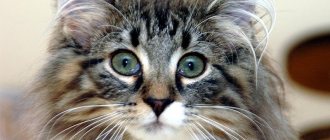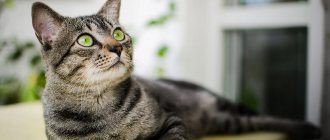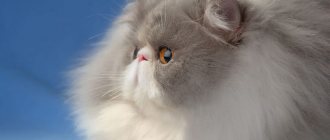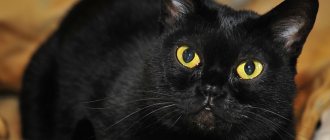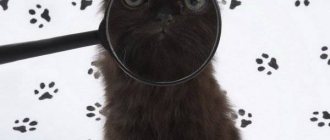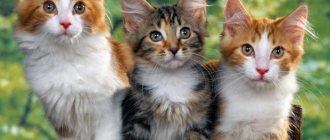The Norwegian Forest Cat is a wonderful new breed of cat, registered in 1979. In Norway they claim that the Varangians brought the ancestors of this breed either from Scotland, or from Ireland, or even from the Middle East. And they argue about the time of taming.
Some say that this is how they have lived since the Vikings. Others claim that less than a hundred years have passed since the Norwegian Forest Cat was taken from the forest. Well, if so, then they quickly became completely domesticated.
It is difficult to find a more devoted, intelligent and patient companion. Precisely a companion, because he will follow you and tell you something.
Video
* We invite you to watch a video about the Norwegian Forest Cat . In fact, in front of you is a playlist in which you can select and watch any of 20 videos about a given cat breed by simply clicking on the button in the upper right corner of the window. In addition, the material contains quite a lot of photos. By looking at them you can find out what a Norwegian Forest Cat looks like.
In this article:
|
Rate the material!
[Total votes: 0 Average: 0]
Despite its name, the Norwegian Forest Cat is a domestic pet. This is a native breed of Norway and its name in local dialects is derived from the word "forest". In its classic version, it really resembles a wild animal, shaggy and striped. The breed is equally well suited for city apartments and rural houses.
Maintenance and care
Although the abundant and dense undercoat suggests that it is difficult to care for, this is not the case. For most forest cats, long hair is easier to care for than for other breeds. As one breeder said:
Mother Nature would not have created a cat that needed a groomer to live in a harsh and dense forest.
For ordinary cats, not premium cats, one brushing session once a week is enough. During molting (usually in spring), this amount is increased 3-4 times a week. This is enough to avoid the formation of tangles.
But preparing a Norwegian forest cat to participate in an exhibition is another story.
Wool is designed by nature to be water-repellent, so it is a little oily. And to look good at an exhibition, the coat must be clean, and each hair must lag behind each other.
The first problem is getting the cat wet. Most breeders recommend shampoo for oily coats, which is rubbed into dry coats. Adding water allows you to get foam, and finally wet the cat. And then regular cat shampoos come into play.
But, every cat is different, and your method of care can only be determined through trial and error. Some cats have drier coats and need regular shampoo. Others (especially cats) have oilier fur and need several lathers.
Some are bi-colored, with white spots that require extra care to clean. But, due to the oiliness of their coats, they all do not need shampoo and conditioner. Instead, it's better to make sure the cat is thoroughly wet.
Even if it seems to you that the wool is already wet, you should continue for a couple more minutes, since the wool is so thick and dense that the shampoo cannot be rubbed into it.
It is just as difficult to dry them as it is to wet them. It is best to leave the wool alone to dry on its own.
Particular attention should be paid to areas on the stomach and paws, as tangles can form there. To avoid them, use a comb and a hairdryer.
History of the origin of Norwegian forest cats
One version of the origin of the breed states that it was given rise to long-haired cats, which were brought to Norway by the Crusaders in the Middle Ages. They were called "Angora", although they are not identical to the modern breed with that name. Having survived in the harsh conditions of the countryside, where cats had to hunt a lot, escape from enemies and endure frosts, the descendants of the ancient Angoras retained their lush fur and acquired a camouflage “wild” coloration.
According to another version, the ancestors of the Norwegian Forest were Viking ship rat catchers. But perhaps its roots are deeper and connected with the wild forest cat, common in Europe. In Norway, such cats lived 5,000 years ago, as evidenced by the discovered remains.
Whoever helped create the breed could only get genes from these three sources. Therefore, the standard does not allow Siamese, chocolate and cinnamon colors, the carriers of which could not enter Norway at the time of the formation of the Norwegian Forest.
Norwegian forest cats became known to felinologists after an exhibition in Oslo in 1938. The red-and-white cat received the status of “National Cat of Norway”. After the war, in 1963, the country's felinologists united into the National Association of Pedigree Cats (NRR). They continued breeding the breed and in 1972 developed a program to preserve it. In 1976, only 100 animals were registered.
Interesting fact: In 1977, the FIFe recognized the Norwegian Forest as an independent breed. Now it is recognized by almost all felinological organizations.
Currently, the Norwegian forest breed is especially popular in its homeland, Sweden, Iceland and France. In our country, it competes with the domestic Siberian cat and the American Maine Coon. Although there are many nurseries specializing in breeding Norwegian Forest (NFO).
Norwegian Forest Cat - description of the breed
According to the CFA standard, the Norwegian Forest Dog is a strongly built animal with a magnificent two-layer coat and a characteristic lynx figure. Individuals of the breed develop slowly, reaching full bloom at the age of about five years. A cat weighs 6-9 kg, a smaller cat weighs 4-6 kg.
Description of Norwegian Forest Cats:
- The head is triangular, the distances from the outer part of the base of the ear to the end of the chin and between the ears are of the same length. The forehead is flat, smoothly rounding towards the crown. The chin is strong, but does not protrude beyond the tip of the nose;
- The neck is short and muscular;
- The ears are medium or large, rounded at the tips, widely spaced, alert. Tassels at the ends are desirable, but not required;
- The eyes are large, almond-shaped, well-opened and expressive, slightly slanted;
- The body is muscular and harmonious, massive but not fat, with a broad chest and strong bones. An impressive appearance is especially important for cats; female cats can look more graceful;
- The legs are muscular, the hind legs are somewhat longer, with powerful thighs;
- The paws are round, large, with lush tufts of hair between the toes;
- The tail is very long and thick. It is valued if its length is equal to the entire body to the base of the neck;
- Coat with a well-defined dense undercoat and long, smooth and hard guard hairs on the sides and back. The collar, sideburns, bib, and trousers on the hind legs are well defined.
Grounds for disqualification:
- Small size, weak bones;
- The head is round or square;
- Profile with a break, the presence of a stop;
- Small eyes, too spaced, narrow;
- Legs short or thin, short tail;
- Clear signs of hybridization, manifested in the color of the Himalayan type or chocolate, cinnamon, lilac.
Where to buy a Norwegian Forest kitten
There are breeders and nurseries in all major cities of Russia and Ukraine.
In Russia
- Nursery “IXTLAN”, Moscow – https://move-ixtlan.ru/;
- “NORTH CAPE*RU”, St. Petersburg – https://northcape.ru/.
In Ukraine
- There are no nurseries
Those who want to buy cheaper can purchase a kitten through bulletin boards on the Internet. They offer the offspring of Norwegian forest cats for 3,000 – 5,000 rubles. (1,500 – 2,100 UAH). However, do not expect that for that kind of money they will sell you a purebred, healthy kitten with good characteristics.
Popular colors of Norwegian forest cats
Numerous colors are described in particular detail in the CFA standard. The colors of the eyelids, paw pads and eyes, which should correspond to each color, are also indicated there. As for the general requirements, green, gold, copper eye colors are acceptable. Cats with white may have blue or different eyes. Skin areas of any color are allowed. Buttons and/or medallions are acceptable in any color. The color of the pubescence around the muzzle and ear tufts is assessed separately.
Abbreviated list of CFA colors:
- Plain. White, black, blue, red, cream. Nose and paw pads match the color of the fur coat or pink if the color is light;
- Chinchilla. Silver - white undercoat, black-tipped guards, white from chin to belly, black eyelids and paws. Golden - the undercoat and underbody are cream, the rest is the same. There are also red (cameo), tortoiseshell, and shaded versions of all of the above colors;
- Smoke. Color black, white undercoat. Nose, eyelids, paws black. Similar smokes of blue, cream, blue-cream, red, tortoiseshell colors;
- Tabby colors. Various spotted and striped patterns. The classic tabby has rings on its legs and neck and an “M” pattern on its forehead. The outer corner of the eye is continued with a line, there are patterns on the cheeks, and butterfly-shaped markings on the shoulders. Lines are drawn along the body, spots in concentric circles on the sides, and the pattern is symmetrical on both sides. Any colors, including in different combinations;
- Calico. White with red and black spots. White legs, belly, chest, muzzle;
- Two-color. Combine spots of any color with white;
- Amber colors. The predominant color is dark honey-chestnut. Kittens are brown. The nose and paws are dark brown or black. There are amber smoke, chinchilla, tabby, and turtle.
Character and habits of Norwegian forest cats
Despite their stern appearance, Norwegians have a gentle disposition and are relatively docile. They are easy to train and can be safely kept in a city apartment. They are balanced, have strong nerves, and can tolerate communication with capricious children and other pets.
They become strongly attached to people from their family and love their company, without which they miss. It cannot be said that they particularly single out the owner - they are friends equally with everyone. They can accompany you on short walks. But they behave reservedly with strangers and do not immediately make contact, gradually getting used to it.
They are active in nature and love to play. They are able to entertain themselves if they are given toys and do not require them to be occupied with them. Able to adapt to any situation after a short period of stress. Having transported them to a new place, you need to leave them in the house for a while so that they get used to the place and calm down among familiar people.
Interesting fact: Norwegians are excellent hunters. They will especially like life in the countryside. Catching rodents is their traditional occupation. But they are no less capable fishermen. They confidently climb trees, and Norse myths emphasize their ability to climb steep cliffs, which is inaccessible to ordinary cats.
Norwegian Forest cats have a quiet voice, but can become loud if kept in a home with a dog. As they say: “Whoever you mess with...”. You should not try to force the cat to sit on your lap - it will begin to express dissatisfaction. This especially applies to females, who are more proud and independent. Cats, as a rule, are more affectionate and more interested in family affairs, taking part in them. On the other hand, one can more likely expect hooligan antics from them.
Features of character and behavior
In terms of its behavior, the Norwegian Forest cat is a calm, balanced breed. The Nordic character of the pet is consistent with the name. A high level of intelligence and a good disposition predetermine a gentle attitude towards people and other animals. However, Norwegians are truly attached to only one family member.
Despite the patient attitude towards strangers, at the first meeting the pet may show anxiety and wariness. But instead of aggressive behavior, the Norwegian forest cat will choose to flee; its character prevents it from entering into an open fight unless necessary. The animal will observe the situation from a safe distance, preferring to hide in cabinets or trees.
The developed cat instinct of the hunter allows Norwegians to independently overcome natural obstacles. Unlike many domestic breeds, the forest cat is able to climb down a tree trunk, head down. This same trait makes the pet overly curious, and also forces it to be very active during the day.
The Norwegian Forest learns quickly and gets used to the litter tray, scratching post and harness.
The pet is rarely mischievous, and with a sufficient number of its own toys, even a kitten will not spoil the owner’s things. The animal actively participates in the life of the family, observing everything that happens, and loves to rest on the owner’s lap.
Interesting facts about Norwegian forest cats
According to fans of the breed, only representatives of the Norwegians are able to descend from a tree like squirrels, upside down - their legs and claws are so strong. Other cats descend with their tails down, looking over their shoulders to judge the distance to the ground. When there is little left to reach it, they turn over and jump off. But tree climbing is an acquired skill taught by one's mother. Kittens raised in an apartment are unlikely to become skilled tree climbers.
The image of a huge cat with long hair - "skogkatta" - is repeatedly found in Scandinavian mythology and medieval literature based on myths. In the Prose Edda by Icelandic writer Snorri Sturluson, the god Thor fights his constant enemy Jormungandr, who takes the form of a giant cat. Thor couldn't lift it, it was so big. Skoggkat were the goddess Freya's pets and two large cats drove her chariot.
Freya had a variety of talents. She was responsible not only for the war, but also for family affairs. Lovers wishing to get married asked for the blessings of Freya and her cats. Because of this custom, superstitions about weddings and cats appeared in Europe. For example, girls who value cats will definitely get married. Or if you step on a cat's tail, you won't get married for a year. Scandinavians believe that feeding your cat well will guarantee sunny weather on your wedding day.
The Norwegian king Olaf V (1903-1991) by decree in 1977 appointed the Norwegian forest cat as the National Cat of Norway. Another example of an officially recognized National Cat is the Turkish Angora, which was declared a national treasure by the Turkish government in the 1920s. Russia has an unofficial national cat – it is a Siberian breed.
How much money do you need for care and maintenance?
When purchasing a purebred pet, you need to evaluate your financial capabilities and know how much it will cost to buy a kitten, accessories for its maintenance and how much you need for monthly quality care.
What to buy for a kitten
Required set:
- Two or three bowls (2 – natural food, 3 – ready-made food). Choose a large bowl for water - Norwegians like to splash water with their paws. Ceramic or metal ones on a stand are best. Price: 380 – 1300 rub.
- Tray. Large with deep sides. Large cats should have room in it. Price: 2700 – 1300 rub.
- Wide-toothed comb and brush with natural bristles: RUB 340 – 600.
- Scratching post. Vertical, wall-mounted for large cats: 900 – 3500 rub.
- Toys. Intellectual pointers, balls, and laser pointers are suitable. Price: 700 – 3000 rub.
- Bed. Large, suitable for dogs: 800 – 1900 rub.
Additional products:
- Plastic carrier with metal door. It is best to take models for dogs. Price: 2500 – 8000 rub.
- Stable vertical play set with weights and sisal scratching posts. Price: 10,000 – 15,000 rub.
- Claw cutter. Price: 350 – 500 rub.
- Harness with leash. Price: 850 – 1500 rub.
- Anti-cat bars for windows. Price: 1800 – 2500 rub.
- Furminator for long-haired cat breeds. Price: 1200 – 2400 rub.
Annual care for a Norwegian forest cat may require from 20 to 60 thousand rubles.
The budget will depend on your capabilities, the chosen diet, the type of filler, and the frequency of treatment and preventive measures.
Feeding pets of this breed is not difficult, but you need to take into account that their coat requires good nutrition: complete, balanced and fortified.
Pros and cons of Norwegian forest cats
Norway is a large and active cat. She eats a lot and requires an active lifestyle. The most optimal place for her to live is a country house. Having the opportunity to walk regularly in any weather, she will be cheerful and will not cause much trouble with care. A free-range cat has fewer health problems.
There is no need to fear that a free cat will go wild. These animals are naturally attached to people and seek their company. They bring affection and warmth.
Pros of this breed:
- It is necessary to comb out, but rarely;
- The cat finds something to do on its own; there is no need to entertain it;
- Tolerant of children and dogs. After a period of adaptation, of course;
- A good hunter and an ardent fighter against rodents are valuable qualities for rural life;
- Has good health;
- Intelligent enough to learn proper behavior in everyday life. Go to the litter box, know what is possible and what is not.
Who should not have this breed? For those who live in the city and are forced to leave often due to their occupation. But I must say that such a person should not have a cat at all. None. The Norwegian in particular can cause trouble due to his penchant for exercise. He is very jumpy and loves to climb on cabinets and any vertical objects, creating a mess.
Another big disadvantage of the breed is seasonal shedding. In the spring, the Norwegian sheds especially heavily, losing his warm undercoat. This is how it is programmed by nature. At this time, it has to be combed out more often than usual, and cleaning the house becomes a burdensome task. In particular, you will have to vacuum daily, not only the floors, but also the sofas.
Breeding Norwegian Forest Cats
Representatives of the breed develop slowly and can be considered fully formed and reach their maximum size only by the age of 5 years. Cats are allowed for breeding no earlier than 2 – 2.5 years; at one and a half years the cat is untied. In the absence of hereditary problems, kittens are born in a complete set (5 - 6 pieces) and have good health. Adult hair grows in a period of 3 to 6 months, replacing the kitten's fluff.
When choosing producers, in addition to health and general compliance with the standard, they pay special attention to the quality of wool. Heavy, dense fur with shiny guard hairs scores more points at shows than coloring. Of course, we must take into account the time of year - in summer, due to molting, Norwegians are much less fluffy than in winter.
Interesting fact: The choice of color depends largely on its demand. For example, we especially love tabby cats, including the most vulgar “gray with stripes” - they most closely match the image of a wild animal. Original colors are in demand, especially the unique amber. The presence of the gene for this color can be determined in a genetic test.
In Europe, they prefer colors with a predominance of white (bicolors, van, calico), as they are closest in color to Viking cats (white with dark spots on the head and at the base of the tail). But the breeder of bicolors must take into account that kittens of this color up to 6 months, that is, until the fur is completely changed, look very unpresentable, which will affect the demand.
Pregnancy in cats is usually easy and takes 55–63 days, and birth occurs without complications. Norwegian cats are good mothers and diligently perform all the functions prescribed by nature; cats are not distinguished by their love of children. At the end of feeding (2.5 - 3 months), Norwegians, like all cats, lose interest in their offspring. This is probably the right approach.
Breeding
Due to their slow maturation, Norwegian Forest cats are considered fully mature at the age of five. Females can be mated no earlier than two and a half years old, males - when they reach one and a half years old. On average, five kittens are born in a litter; their health directly depends on the gene pool of the parents.
Norwegian cats endure pregnancy relatively easily, and childbirth most often occurs without complications.
When choosing a pair for mating, you need to pay attention to pedigree, health, compliance with breed standards, and it is also important to check the quality of the coat, which is paid more attention to in competitions than color.
On average, five to six babies are born in a Norwegian litter.
Caring for Norwegian Forest Cats
Norwegian Forest cats will require the same standard procedures as all domestic cats. These include proper feeding and regular visits to the veterinary clinic for vaccinations. Kittens receive their first vaccinations against viral infections in the nursery at 6-8 weeks; the owner can only continue the annual vaccination. Outdoor cats require rabies vaccinations.
Grooming will require purchasing a set of fine-tooth and wide-tooth combs. Some people like to use a slicker if the cat allows it. Domestic hermits are scratched 2-3 times a week, and more often in spring and autumn, during the molting period. Combing will be useful not only for the pet, but also for the owner, who will partly protect the upholstered furniture from contamination.
Besides:
- You can bathe Norwegians only in extreme cases, since the wool has a water-repellent coating and it is not advisable to wash it off;
- It may be necessary to trim the nails if the pet itself does not grind them down effectively. Don’t forget that a scratching post is an integral element of a cat owner’s home. Like the tattered sofa;
- There are some specificities in the choice of litter for the Norwegian toilet. They carry its crumbs very effectively on their furry legs, and they are better off with wood filler with large granules;
- Representatives of the breed need physical exercise. They will need equipment for training, although in the absence of this they will make do with jumping on cabinets and hanging objects.
And the most important. If a cat is not intended for breeding, it must be neutered. Hormone surges are not good for anyone; animals suffer more from them than from unfulfilled hopes that they do not even experience. And if the cat is walking, then you can get into a lot of trouble with useless bastards, treatment of wounds and broken eyes.
FAQ
How many live at home?
With good care and nutrition, healthy representatives of the Norwegian breed live a long time. On average - 14-16 years. They can live more than 20 years; such cases have been recorded in the history of this breed.
What is the weight of an adult and a kitten?
Norwegian cats are larger than cats. At six months they can weigh 3-4 kg, by two years 7-8 kg. Kittens at 6 months weigh about 1.5 kg, at two years they reach a weight of 4-5.5 kg.
Is it easy to hold?
The cat is not tame. Norwegians value their own and their personal space.
They do not like to sit on their laps, preferring to be close to them, curled up in a ball. They don't like to be kissed, but they love to be stroked and scratched. As a sign of love and appreciation, they can “butt” a person’s forehead or legs.
Can I keep it outside?
We have already written that in Europe cats are kept in cages in nurseries. But this applies only to adults who have lived and been raised in a family since childhood. Kittens cannot be placed in enclosures. Yes, cats can withstand the harsh conditions of the street, but they run wild there. An aviary is needed for walking this breed. Fresh air has a beneficial effect on the quality of their luxurious coat and improves their appetite.
How aggressive is the breed?
Norwegian Forest is absolutely not aggressive. Representatives of this breed do not show aggression towards children, other pets, or strangers. They are calm and balanced. They don’t divide the territory, they don’t start wars. Behind the stern appearance hides a gentle, good-natured animal.
Do they like to claw/climb?
The forest cat's favorite pastime is climbing trees. This is what the Norwegian forest dog does with pleasure. There are no heights that are inaccessible to them. Cats deftly climb vertical walls, doors, and cabinet doors. What is surprising is their ability to descend upside down - they do it without panic, quickly and easily. Cats are smart, so it won’t be difficult to train them to scratch their claws on a scratching post.
Is this breed hypoallergenic?
The breed is not hypoallergenic. The fur of a Norwegian cat can cause allergies.
Do you need to take care of your fur?
The Norwegian's double coat requires regular grooming. Under normal conditions, it is enough to brush your cat 1-2 times a week. During the molting period, they do this daily and use a furminator.
What color are eyes?
Almost anyone. A golden-green shade is preferable, but copper, gold, and green can also be used. White cats have blue eyes.
Is the breed prone to heart disease?
Unfortunately, nature did not spare these large, strong cats. They live easily in harsh conditions, but can inherit heart disease such as hypertrophic cardiomyopathy.
At what age do they stop growing?
Like all native breeds, Norwegian cats develop slowly and mature late. They reach full maturity by 4-5 years, while they retain the temperament of a kitten almost all their lives.
Diet of Norwegian Forest Cats
Large and agile, Norwegians eat relatively a lot. The Royal Canin brand line includes food designed for this breed. When choosing ready-made feeds, you need to pay attention to their purpose. Giving preference to diets “for healthy skin and coat” and “for active cats” if the pet is really active.
Interesting fact: The convenience of dry food and canned food is that they are balanced taking into account the health and lifestyle of the pet. At least premium food and higher. Over time, every owner of a mustachioed creature acquires the ability to understand the composition and evaluate the ratio of components.
Those who prefer to feed their cat natural food will have to purchase not only meat products, but vegetables and cereals. For meat products, lean beef, turkey, chicken, and offal (any kind, although liver should not be abused) are preferred. They feed both boiled and raw meat, not forgetting about worms. It is advisable not to introduce fatty foods.
Porridge (rice, rolled oats, buckwheat) in its pure form can be given for unloading, but can be mixed with meat or dairy products. Vegetables (zucchini, broccoli, potatoes) are boiled and mixed with meat. Although hungry cats can consume them in their pure form. Cats are not picky about the appearance of dishes and you don’t have to bother with this.
Dairy products, especially fermented milk, are required. Some cat owners are prejudiced against milk, but it all depends on how the cat herself feels about it. Some people love it very much. You can give eggs in small quantities. Fish, raw or cooked, is necessary in some quantity.
An indicator of a complete balanced diet is a shiny coat and the results of digestion in the tray. The disorder is corrected by changing the diet or adding new components to it: vitamins, sprouted grass, kefir and raw liver to strengthen or milk to weaken.
Description of Scottish Fold cats
This is a medium-sized breed with large eyes and curled ears. Fold-eared cats quickly get used to new people. They are obedient and sociable, building good relationships with dogs and children. The family chooses a favorite and stays near him more often. The pet loves to play, especially at a young age. If the owner is away from home for a long time, the animal may become sad. This breed is susceptible to spinal diseases, as the gene responsible for the shape of the ears affects skeletal health. Therefore, before getting Scots, you need to weigh the pros and cons. They do not need special care, as they do not have long, thick fur. An amazing feature is that lop-eared cats love to sleep on their backs.
Diseases and health problems
The Norwegian Forest's lifespan is typically 14 to 16 years in the absence of serious disease. And they are found, mainly renal and cardiac. Type IV glycogenosis can be considered breed-specific, which occurs due to a hereditary disorder of glycogen metabolism, the source of glucose in the body. This leads to neuromuscular degeneration and early death in kittens, which usually do not survive until six months of age. Detected by genetic testing.
Other cat ailments include:
- Hypertrophic cardiomyopathy (HCM) is a disease of different breeds with a hereditary predisposition; there are no special tests to detect it in Norwegians. Can be detected if an ultrasound is performed annually;
- Hip dysplasia is a congenital disease. Leads to lameness, very painful. Detected by radiography;
- Polycystic kidney disease is a hereditary pathology that leads to kidney failure. Can be detected at an early age by doing an ultrasound;
- ICD is a disease with an unknown cause. It is often attributed to poor nutrition. Indeed, medicinal foods selected for the struvite and/or oxalate type of disease, respectively, help the cat get rid of stones. But what matters most is hereditary predisposition and a sedentary lifestyle.
Cats are susceptible to many diseases, and you need to monitor your pet carefully. Some serious problems can be avoided if you go to the doctor in a timely manner. Owners of free-living cats should make it a rule to carry out twice annual treatment for parasites: worms, fleas, ticks. There are complex drugs. You shouldn't rely on collars; they are not very effective.
Appearance
Norway's national treasure, the Viking Cat, is distinguished by its strong, muscular body and fluffy, thick coat, ideal for the harsh conditions of Scandinavia. The Norwegian Forest Cat is described in all international standards, each of which has different requirements for the exterior. The main characteristics are similar, but there are a number of differences.
Let's look at how the WCF standard describes the Norwegian breed.
Breed standard according to the WCF system
- Body . Elongated, strong, with massive bones. Sizes – from medium to large.
- Head . In the shape of an equilateral triangle.
- Muzzle . The profile is long and straight, without a stop.
- Ears . Big ones. The base is wide. Located very high on the head. The outer line of the ear runs along the cheeks in a straight line. The ears have a long edge on the inside. There are “lynx” tassels at the tips.
- Chin . Solid.
- Nose . Not described by the standard.
- Eyes . Oval shaped, large and wide open. The color is even and matches the coat color.
- Limbs . Muscular, long. The hind ones are longer than the front ones.
- Paws . Round shape, wide. Between the fingers there are tufts of wool.
- Tail . Very long and fluffy. Must be equal to body length or greater.
- Wool . Double layer. The upper guard hair is long, shiny, hard, and has water-repellent characteristics. The undercoat is thick and fluffy. The guard hair covers only: the back, sides, forelimbs, outer part of the hind limbs and the upper part of the tail. The lower part of the body and the back of the hind legs have only undercoat. On the hind legs there are “breeches.” A triangle-shaped beard hangs from the cheeks.
- Neck . The fur on the neck forms a “jabot”.
- Color . The standard allows any colors and patterns. The exceptions are chocolate, cinnamon (red-brown), lilac and fawn (fawn). Solid coat color should be uniform. The pattern of spots in bicolor and tabby patterns should be clear and distinguishable. Any amount of white is allowed.
- Drawing . All species are allowed: tabby (marble, spot, stripe), tortoiseshell, mackerel, van, harlequin, wild. Color point is prohibited.
- Weight . Females - 3.5 - 5.5 kg, females - 4.5 - 7.5 kg.
- Height at withers . From 30 to 40 cm. Short individuals are considered a disadvantage.
- Lifespan . From 14 to 16 years old.
Important!
Among cats there are long-livers, whose life expectancy is more than 20 years.
